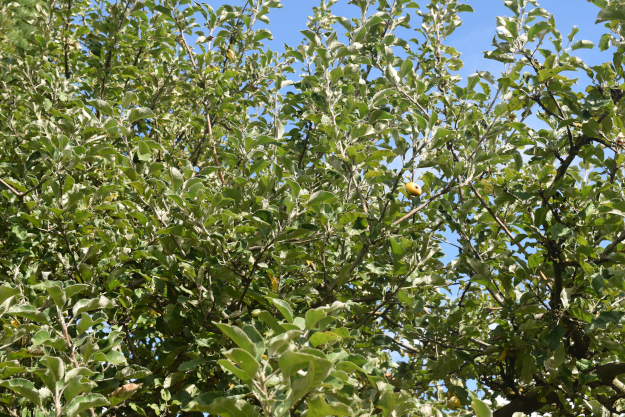
It’s mid-May, and I’m working in my garden when I hear voices coming from the direction of my neighbor’s apple tree. Peeking over the fence, I see two men with saws and pole pruners. I feel a flutter of apprehension. I’ve seen the carnage that untrained tree trimmers can inflict on a tree, and the lack of safety equipment tells me that these gentlemen are not Certified Arborists.
Certainly, the old tree could use some pruning. From the looks of it, it has never been pruned. I’m guessing it’s been growing there as a free spirit for 60 years or more; it was probably planted shortly after the little ranch house was built in 1956. Now, its five sturdy trunks, each spanning 10 inches across, form a vase-shaped canopy that fills nearly half the backyard. Smaller branches, clothed in fresh green foliage, sprout from the main trunks in profusion. Each fall, the apple crop is abundant, though the fruits are rather sour. The tree is healthy and productive.
I go back to working in my garden and try to tune out the sound of falling branches. I’m renovating my garden this year, replacing most of my purely ornamental plants with more wildlife-friendly options. I’ve been reading about gardening for wildlife, and it’s got me eager to make some changes. I’m encouraged by the diversity of insects I’m already starting to see. I’m learning about the bees and bugs and wasps and dragonflies that dwell in my garden, and I’m loving it.
I glance at the apple tree. The men have removed some of the lower branches and there’s a glimmer of light under the tree. The shade is less oppressive there now. I’m hopeful. I go inside and take a break.
I try not to keep checking out the window, but I can’t help myself. It’s not good. The men are working slowly but steadily, and more and more branches are coming down. Should I say something? What can I do? The men are just doing their job, and the landlord is nowhere to be found. I haven’t seen her since she bought the place four years ago.
When I go back outside, it hits me. These men are not pruning the tree. They’re cutting it down. These are not pruning cuts. These are the kind of cuts you make to a tree that’s being removed. Large limbs, cut straight across, leaving gaping wounds. The tree’s shape utterly destroyed. Masses of foliage removed, with little left for photosynthesis.
In the seven years I’ve lived next to this old tree, I’ve never given it much thought. Now, I’m crestfallen. I can see how it’s blocked the view to other backyards, and I realize how it has sheltered my garden from the blustery east winds that rip through our neighborhood. More importantly, I think of the countless native bees and other pollinators nourished by its flowers each spring and of the many caterpillar species that feed on its foliage (155 of them in the Portland area, according to the National Wildlife Foundation website). I think of the songbirds, in turn, who rely on those caterpillars to feed their chicks and who nest and perch in its branches. All that habitat will be gone.
It’s getting late. It will be dark soon. The men are still working. What’s taking so long? Let’s just get it over with.
They’re packing up! They’re not taking the tree down after all. They’ve topped it, and now they’re leaving. I don’t know which is worse—topping a tree and ruining its shape for the rest of its life, or taking it out altogether despite it being perfectly healthy. All I know is, I have a knot in my stomach.
I’ve recently read A New Garden Ethic: Cultivating Defiant Compassion for an Uncertain Future by Benjamin Vogt. It’s a thoughtful, inspiring book about gardening in an era of global warming and mass extinctions. One passage in particular keeps coming back to me: “Be willing to love with a broken heart,” he says, “to foster that breaking and touch the world that so many hold at a distance to protect their identity.” Faced with sad stories about habitat destruction on a daily basis, many of us turn away in despair. We must remain engaged, Vogt says, and keep fighting for nature, even though at times it breaks our heart to acknowledge what we’ve done to it.
“I don’t want to always feel better in my garden,” Vogt writes in A New Garden Ethic. “I don’t want to be healed. I need my pain. I need my anger. These emotions are not enemies but indicators of empathy and compassion. They let me know the depth of my feeling and the power of all life struggling for justice and equality.”
In the days and weeks that follow, when I glimpse that tortured tree, I respond with anger and sadness, but also love. Not giving in to despair, I do what I can to give wildlife a fighting chance. I plant more natives in my garden—willow, chokecherry, serviceberry, madrone, oceanspray, goldenrod, gumweed, sidalcea. I sow sunflowers, phacelia, California poppies. I install a small wildlife pond. I clear patches of bare soil for ground-nesting bees, who cannot burrow through thick mulch. I build rock piles and log piles and leave my garden messy. And I write. I write with love, and a broken heart.

